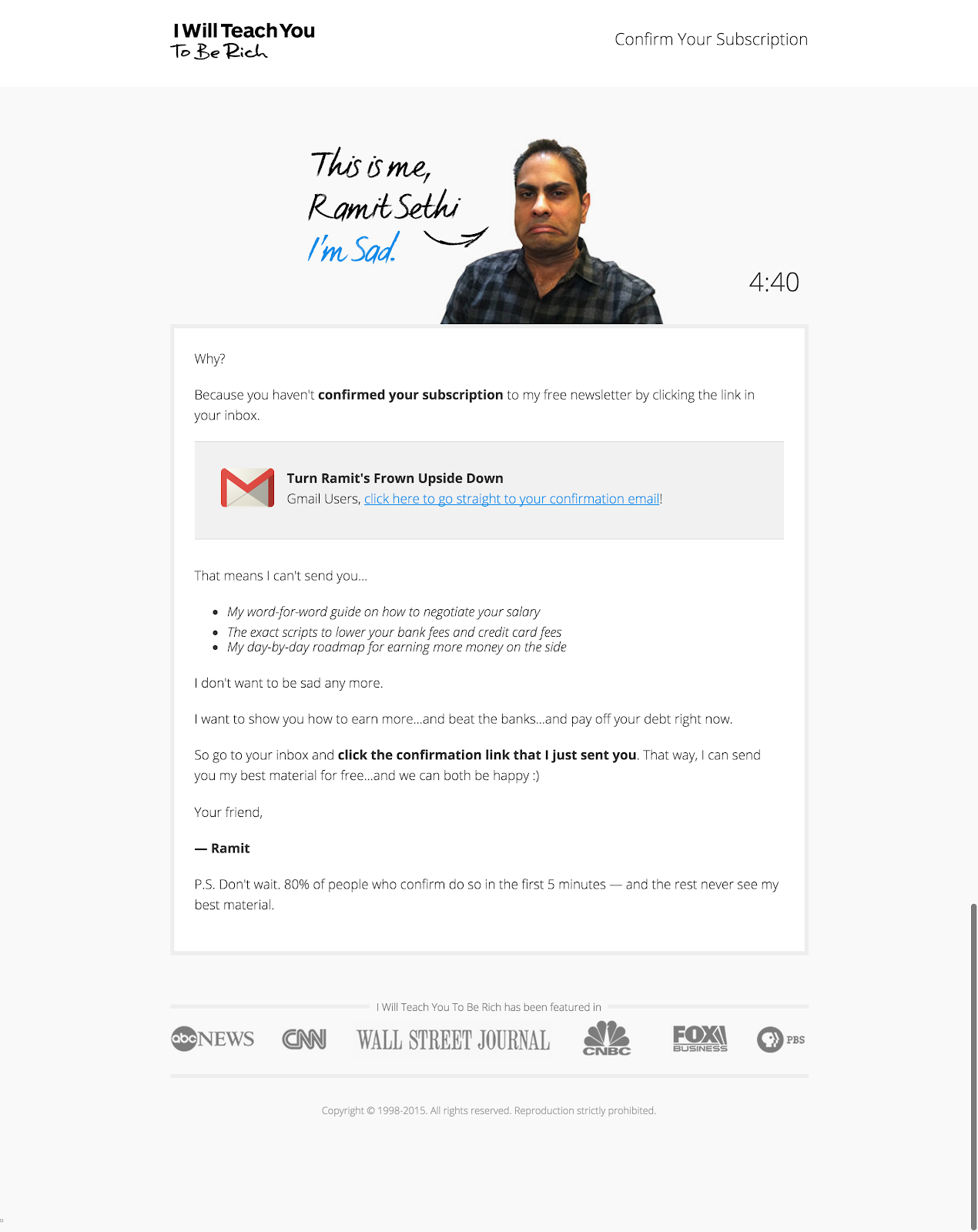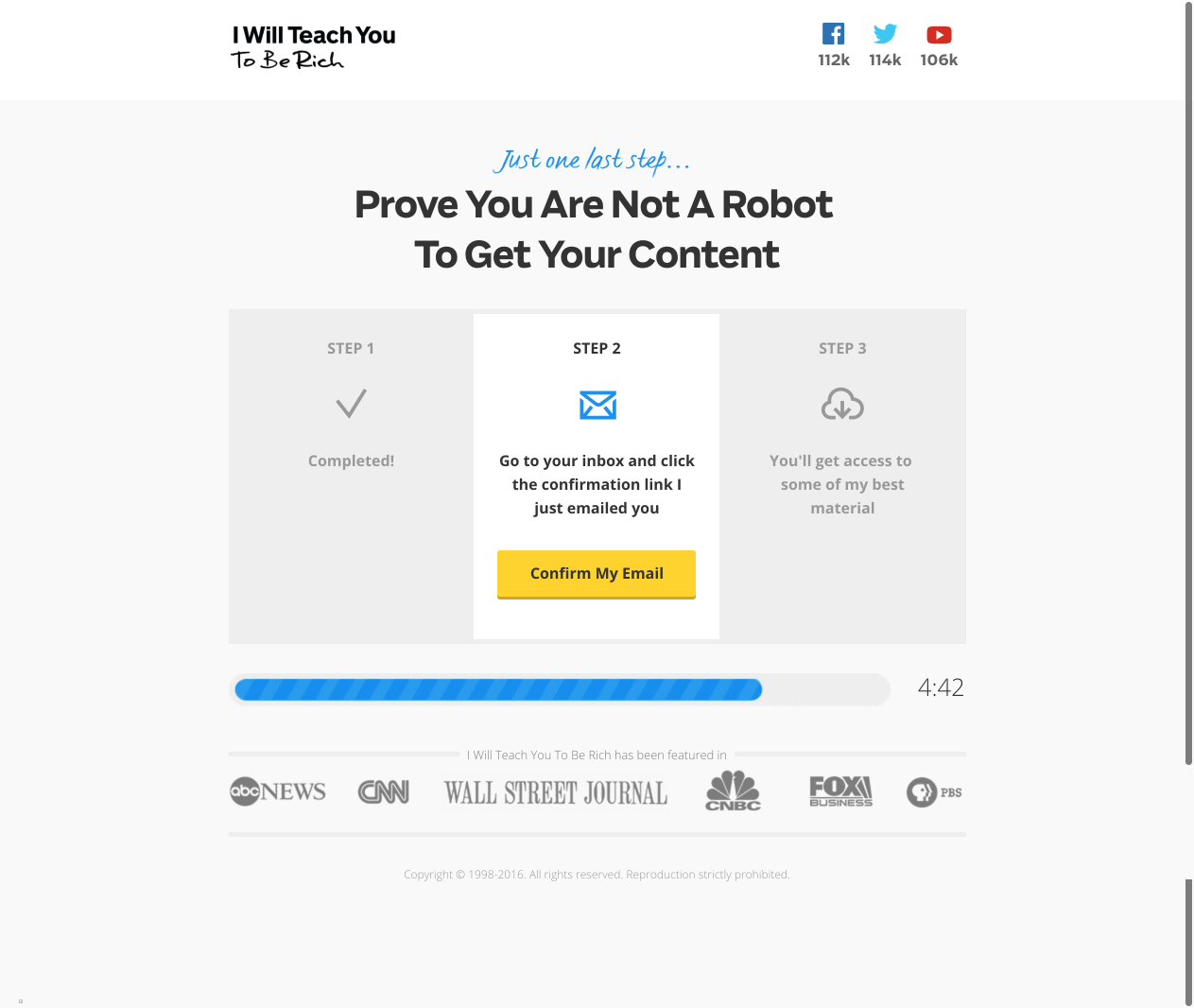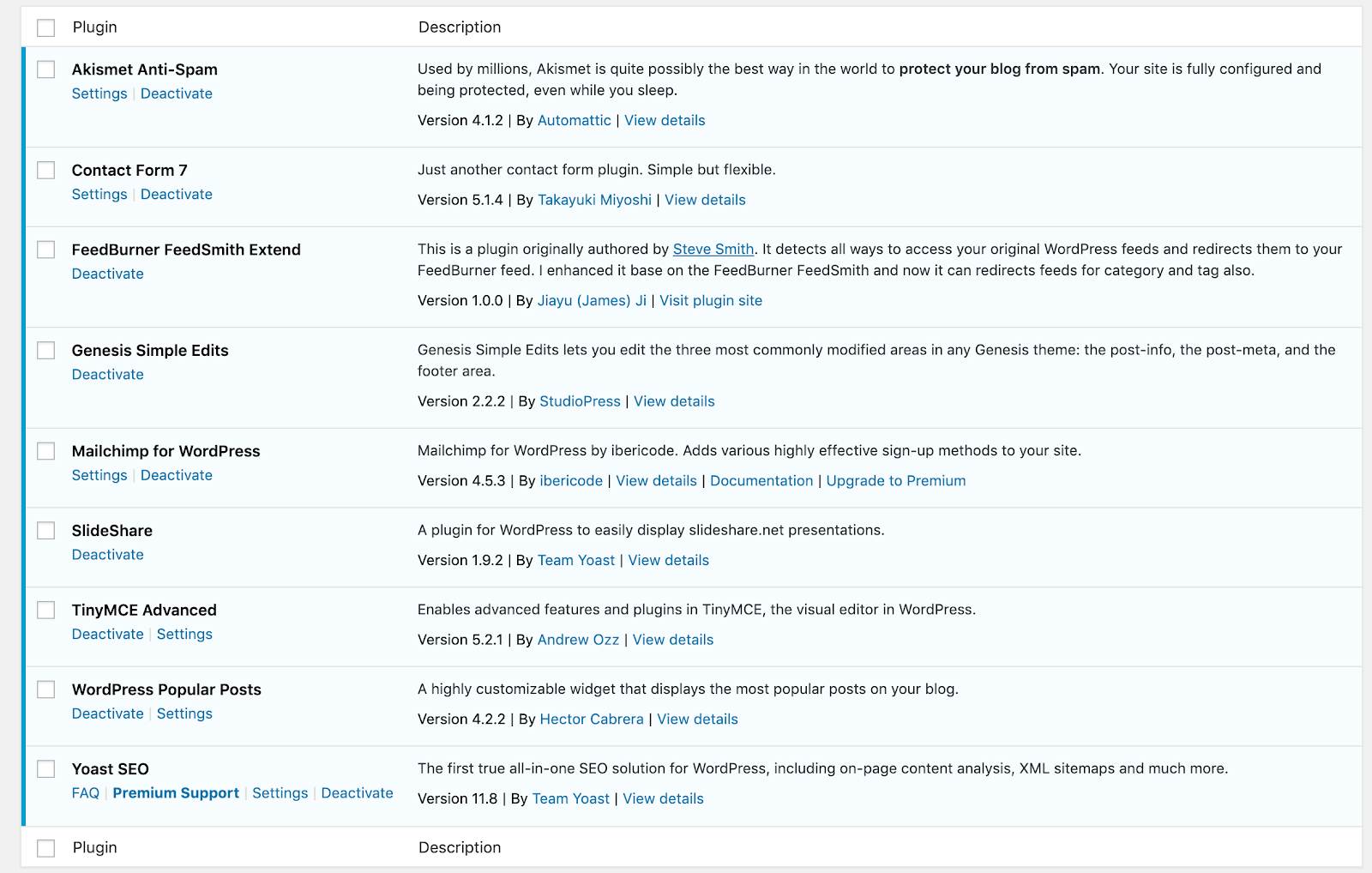In 2016, I led the growth team at I Will Teach You to Be Rich and generated more than 40,000 leads per month.
Here’s our cumulative lead volume compared to our goal for the year:

I’m going to walk you through how I did it and why I’d never do things that way again.
%(tableofcontents)
My Shameful Secret From Growing Our Leads
I don’t think I’ve said this publicly before.
I’ve tried to avoid mentioning it.
During that glorious lead generation year, we didn’t increase traffic at all. Total traffic in 2016 was nearly identical to traffic in 2015. It might have actually shrank slightly.
As someone who's built their career in online marketing, that’s embarrassing. But that’s not the shameful part.
So how’d we do it then?
Where did the leads come from?
For the most part, we optimized the traffic we already had.
I took the growth program I developed while I was leading the marketing team at KISSmetrics and rolled it out on I Will Teach You To Be Rich.[*]
The program focused heavily on A/B testing and optimizing funnels.
It took me most of 2015 to get the program in place.
It included three main components:
-
Getting A/B testing tools and data in place.
-
A fully functional growth team including five marketers, a designer, and two engineers.
-
Several months of running A/B tests so the team worked out the kinks in the process. It takes a few months of testing before a new team feels comfortable with the work flows and everything runs smoothly.
By January 1, 2016, we came out swinging. We crushed our January lead goal and kept hitting our monthly goals all year long.
At the end of 2016, we averaged 40,000 leads PER MONTH.
These were brand-new double opt-in email subscribers we could pitch our products to. Looking back, that volume was insane.
The shameful part is I set us up for a brutal 2017.
While 2016 was glorious, 2017 was one giant fire drill.
In January 2017, our total traffic started dropping, all from losses in search traffic. By mid-February, we were down by about 40%.

We then spent the next two years scrambling and never got back to our traffic levels before the drop. While I had my team aggressively driving conversions, we let a bunch of site debt pile up:
-
Thousands of landing pages, many of which were broken, had never been taken down
-
Duplicate content across multiple subdomains
-
Lots of blog posts outside our main categories
-
Hundreds of thin blog posts that needed to be removed
I knew these were problems, but I never bothered to fix them. I figured we could come back to it later.
Then in January 2017, Google decided it was time to collect on that debt and lowered all our search rankings across the site.
Up until I left my role at I Will Teach You To Be Rich in December, 2018, we never hit the same lead volume we had in 2016. We took too hard of a hit on traffic, our conversion wins couldn’t cover the gap.
The drop in traffic is my shameful secret.
While I can sit here and brag about those leads of 2016, I have to remind myself this same program allowed a brutal Google hit to take place.
Because of how badly my program did in 2017, I wouldn’t build that same growth program again. I’d do things entirely different today.
First, I doubt I’ll ever focus so heavily on A/B tests again. Unless you have a user-driven business model like Facebook or Uber, conversion wins can only take you so far. I’d rather have a program that can grow traffic year in and year out.
Second, I always start with a deep site audit now before building my long-term growth program. I never want to get blindsided by a huge traffic drop again.
Let’s break down the old program, and I’ll walk you through where those 40,000 leads per month came from.
Buying Our Way With Facebook Paid Leads
If you absolutely need to hit a lead goal, there is always a way to do it if you’re willing to spend enough money.
When I joined the team, we were spending $170,000 per month on Facebook ads. This drove tens of thousands of leads every month. Two of the marketers on our team spent their time exclusively on paid.
During 2017, we took the same A/B testing program that we were using on the site and applied it to our Facebook ad funnels.
Over the course of the year, we dropped our average cost per lead from $10 to $2.50.
Those wins allowed us to keep our lead volume up while reducing our budget.
Wait. Why didn’t we just increase our lead volume?
We had doubts about the profitability of our leads during this period and started doing a lot of testing around profit instead of raw lead volume.
The point is that our paid leads padded our lead totals quite a bit. We had over 100,000 Facebook paid leads in 2017, a good 20-25% of our total lead volume.
If you’re willing to buy your way to lead growth, it can be done. Large budgets combined with non-stop A/B testing on your Facebook ads can get you the lead volume that you need.
Conversion Wins For Organic Leads
Like I said, our total traffic didn’t grow at all.
Instead of growing traffic, we focused exclusively on increasing conversion rates. That is where all of our organic lead growth came from.
My growth program includes a disciplined approach to A/B testing.
There are seven rules I make my teams follow:[*]
-
Above all else, the control stands.
-
Get 2000+ people through the test within 30 days.
-
Always wait at least a week.
-
Only launch variants at 99% statistical significance.
-
If a test drops below a 10% lift, kill it.
-
If no winner after one month, kill it.
-
Build your next test while waiting for your data.
Our designer and two engineers researched, built, and ran A/B tests around the clock. We had 5-6 A/B tests running at any given moment, prioritizing our homepage, pop-up, and double confirmation page.
Most of the tests didn’t hit statistical significance, a few made things worse, and a couple were major wins.
My A/B testing system focuses on:
-
Cycling through tests really quickly.
-
Finding the few 20-30% conversion wins.
-
Keeping those wins so they can stack on top of each other. For example, finding the best headline, design, CTA and other elements in your funnel can all be combined to impact your total conversion rate.
Once you find a few conversion wins at the same step of the funnel, you’ll double or even triple conversions.
For example, we spent a bunch of time running A/B tests on our exit pop-up on the site.
Here’s what it looked like in August 2015:

And here’s what it looked like in August 2016:

A couple of tips on getting similar wins for your site:
-
First, ad a pop-up. I know we all hate pop-ups, so do I. But they work too well, they’re the single biggest lead driver on any site.
-
To avoid making your audience angry, only show your pop-up once per visitor. Also only show it 30 seconds after the page loads. Make it super easy to click out of too.
-
Make it a full-page pop-up.
-
Try 3-5 different offers on the pop-up to find the best one. You don’t need to A/B test these. When you have a real winner, you’ll feel it. Try a few different offers in a row until you feel a spike in lead volume. Then keep that offer.
This version quadrupled leads from our pop-up. And since the pop-up ran across the entire site, that’s an enormous impact on conversions.
A few wins like this throughout the year and you’ll crush your lead goals.
We also found several major wins on our double opt-in confirmation page that improved the percentage of email opt-ins that double confirmed their email.
The original confirmation page had a 63% conversion rate:

This is the version that got us to an 82% conversion rate:

Some of the wins from this page that you should copy:
-
The page layout and the three steps worked very well, I’d copy that same structure on any double confirmation page.
-
The countdown timer and progress bar did give us a win but I’ve found that these elements aren’t winners consistently. We tried other timers and progress bars that didn’t impact conversions. For whatever reason, this one did give us a conversion boost.
-
The social logos at the top were a small boost. Great example of social proof.
-
The yellow CTA button is coded to go straight to Gmail and search for the “from” email address that sends the confirmation email. This pulls up the email in one click and got us a nice conversion win. For non-Gmail users, there wasn’t a CTA button at all. I’d replicate this on any CTA that pushes users to their inbox.
Since every lead went through that page, every increase in the conversion rate went straight to our lead total. It had a massive impact.
I always focus on the site assets that have the biggest influence on total conversions.
For us, this included the:
-
Homepage.
-
Double confirmation page.
-
Pop-up.
We tested a few other pages but those three drove the bulk of our organic lead growth.
Doubling Affiliate Leads
For info-product businesses, one of the tried and true lead sources is affiliates. Find other info-product folks in your same category, build relationships with them, and persuade them to promote your products for a cut of the revenue. A few tips on making the pitch:
-
It really helps if you already have a relationship with the person before you ask them to promote your product. Build genuine relationships with anyone else doing info-products in your same category (fitness, business, finance, etc).
-
A 50/50 split on revenue and minus refunds is standard in the info-product industry.
-
Affiliates love reciprocation. If you want to close an affiliate, promote their product first.
We grew from about 40K affiliate leads in 2015 to 96K in 2016.
To be honest, I can’t really say “we.” I had little, if nothing to do with this lead growth. Our Affiliate Manager at the time, Colleen Taylor, had a ton of experience in this space and did an amazing job. All the credit goes to her.
If you’re considering building an affiliate program, I have a few pieces of advice:
-
Never stop recruitment. Affiliates come and go. Most will have 1-2 great launches with you and then slow down. Sustained growth depends on recruiting new affiliates over time.
-
Most of your affiliate leads and revenue will come from 1-2 affiliates. Affiliates definitely obey power-law dynamics. A handful contribute all the returns. Unfortunately, you won’t know which ones are the big winners ahead of time.
-
For info products, focus on affiliates who are personal brands. We did multiple partnerships with larger companies and those leads didn’t convert nearly as well.
Why I Wouldn’t Build That Growth Program Again
When a manager joins a new company, they tend to run the same program that worked for them at their last role.
That’s exactly what I did.
I had a conversion optimization program that worked really well at KISSmetrics so I used it without understanding the limitations. It allowed me to drive growth without solving two fundamental problems:
-
The site debt that would eventually weigh the site down and decrease our traffic.
-
No genuine program to increase traffic. All the traffic we had gained previously was the result of luck and having a really engaged audience.
While I spent a year and a half driving conversions, I also opened up a severe vulnerability. Not only would Google come and collect on our site debt, but I wouldn’t have a traffic engine in place when it did.
Then we got hit with that 40% drop.
My best theory for what caused the drop is that after we launched a new WordPress theme, Google recrawled our entire site and reevaluated all the low-quality content that was still live.
We had thousands of terrible blog posts, duplicate content, a mess of domains, and broken landing pages.
We stopped the decline and reversed it slightly by doing a huge site audit and purge. We removed thousands of pages.
But we didn’t have a real traffic engine in place to build momentum afterward.
Purging a site is starting to become a best practice in SEO circles now.[*]
Step one when you start working on a site for the first time is to audit the site and remove low-quality content that isn’t generating traffic or links.
This is where I start today.
I do whatever it takes to make the site healthy. On a large site that already has 100,000+ visitors/month, I plan on 3-6 months of cleanup to make it rock-solid.
Only then do I start working on conversion optimization and traffic growth programs.
Here are some of the bigger items I get fixed:
-
Get hosting cleaned up. I’m always surprised by how much stuff gets split between among hosts at the same company. One blog is on WP Engine, another is on AWS, stuff is split among different AWS accounts — there’s almost always something. My recommendations on the best web hosts are here.
-
Get the marketing scripts cleaned up. There’s always a bunch of marketing tools that have been installed and abandoned. Those slow down your site a lot. Get everything in Google Tag Manager and remove anything you’re not actively using. This will make script maintenance a lot easier later. I start by using the Chrome inspect tool and looking at all the scripts in the <head> section of the site. I’ll do this on blog posts, landing pages, the home page, and and a few other key pages on the site since it’s common for scripts to get installed inconsistently.
-
Clean up the WordPress plugins. This is a pet peeve of mine. Lots of folks have dozens or hundreds of plugins installed. I hate having more than 5-10. More than that has little value and extra plugins create security risks along with lots of opportunities for site bugs. My favorite plugins are Yoast SEO, Akismet, the classic WordPress editor since the new one is so terrible, a form plugin, and that’s about it. Here’s the plugins on one of my sites and I even think this is bloated:

-
Look at every active URL on the site. I’m serious about this one, it’s the only real way to get a deep feel for a new site. This will save your bacon later. I deeply regret not doing this when I started at I Will Teach You To Be Rich. Use a site crawler like Screaming Frog to get a full list of pages.
-
Aggressively delete pages that aren’t providing value so they 404. For an organic search program, that means any page that doesn’t drive traffic or links needs to go. If taking them down will take too long, you can noindex them. I still prefer to kill the pages though; it’s the only permanent solution. I’ll use Google Analytics for traffic data and Ahrefs for link data. I start by exporting data from each on all URLs for the site, then I combine into a single spreadsheet in order to find the pages with neither. You’ll end up with a spreadsheet like the one below where two URLs have been marked for removal since they have low traffic and links:

-
The longer your site themes and stylesheets have been around, the more debt they’ll have. I like to do a round of cleanup on both. I am assuming that you have designers and developers building your site for you. If you’re using an out-of-the-box WordPress theme, the original theme developer often maintains the theme and you won’t have to worry about this.
How To Get A Quick Win
Not all of us have the luxury of spending 3-6 months on foundational work at a new job. Especially as a new function manager, you’ll have pressure to produce wins and build credibility within the team. I’ve been there plenty of times myself.
Any great executive will have a few quick win projects that they can play in the first 30-90 days. Once wins are on the board, then they can go after the bigger challenges that don’t have immediate payoffs.
I put together my 5 Step Process For Finding Major Funnel Wins On The Cheap.
Whenever I use this, I get a major conversion win on the site with a week of work and $500-1000 in ad spend.
With a big win, I have the credibility I need to start pushing my foundational projects through.
Add A Comment
VIEW THE COMMENTS